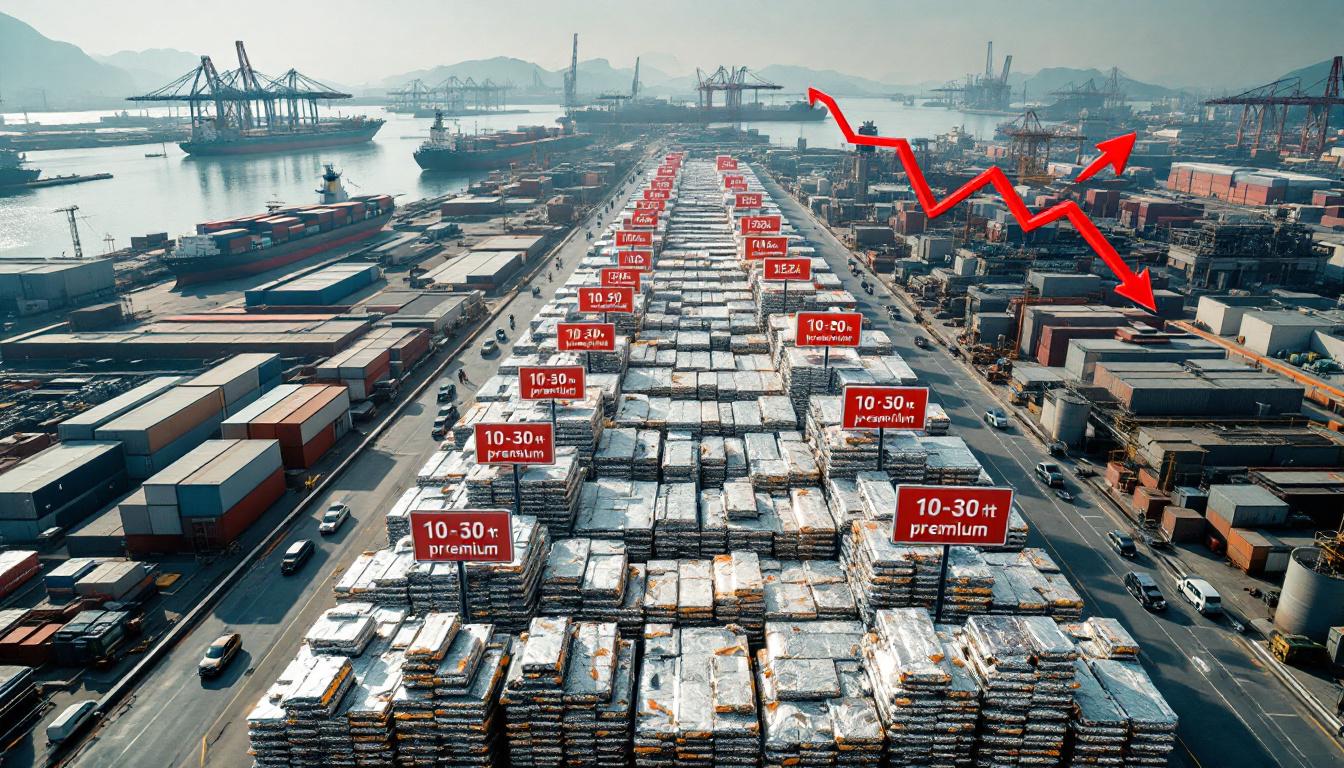Chrome Mining and Export Tax in South Africa: Industry Perspectives and Policy Implications
South Africa's chrome industry stands at a critical crossroads where policy decisions could dramatically reshape its future. As the world's leading producer of chrome concentrate, the country faces complex challenges balancing raw material exports against value-added processing. This analysis examines the current state of South Africa's chrome mining and export tax in South Africa, proposed government interventions, industry responses, and potential economic implications.
What is the Current State of South Africa's Chrome Industry?
South Africa has cemented its position as the global leader in chrome concentrate production, with 2024 marking a watershed year for the sector. Export volumes reached an unprecedented 20.5 million tonnes, generating R84.6 billion in revenue according to South African Revenue Service (SARS) data. This exceptional performance underscores the sector's vital contribution to the national economy.
The chrome mining sector has demonstrated remarkable resilience and growth over three decades. Between 1994 and 2024, production expanded at an inflation-adjusted annual average rate of 8.4%, significantly outperforming the broader non-gold mining sector. This growth trajectory establishes chrome mining as one of South Africa's most successful mining subsectors.
South Africa's Global Position in Chrome Production
The country's dominance in chrome production stems from its vast reserves within the Bushveld Igneous Complex—a geological formation containing approximately 70% of the world's known chromite resources. This natural advantage has allowed South Africa to maintain approximately 40% of global chrome ore production despite increasing competition from emerging producers.
Chrome's metallurgical properties—particularly its importance in stainless steel production—ensure consistent global demand. South Africa's high-grade chromite reserves, with chrome-to-iron ratios exceeding 1.5:1, are particularly valued in international markets for their superior quality.
Chrome Mining's Growth Trajectory
While many traditional mining sectors in South Africa have contracted over recent decades, chrome mining has bucked this trend with consistent expansion. The sector's growth can be attributed to several factors:
- Resource abundance: The Bushveld Complex contains enough chromite reserves to support production for decades.
- Operational efficiency: South African chrome miners have developed specialized extraction techniques for the country's unique ore bodies.
- Export orientation: The sector has successfully pivoted toward international markets, particularly China.
- Metallurgical grade diversity: South Africa produces both chemical and metallurgical grade chrome, serving diverse markets.
Employment and Economic Impact
Chrome mining has emerged as a consistent job creator in South Africa's mining landscape, expanding employment opportunities while other mining sectors have contracted. The industry directly supports thousands of jobs, with particularly significant impact in rural communities of Limpopo and North West provinces.
Beyond direct employment, chrome mining generates substantial economic multipliers through:
- Local supplier development programs
- Infrastructure investments in mining communities
- Skills development initiatives
- Enterprise development in mining regions
Why Has South Africa Lost Its Ferrochrome Dominance?
Despite South Africa's leadership in chrome concentrate production, the country has ceded its once-dominant position in ferrochrome production to China. This shift represents a fundamental restructuring of the global chrome value chain, with significant implications for South Africa's mineral beneficiation opportunities.
China's Rise in Ferrochrome Production
China has strategically positioned itself as the world's primary ferrochrome producer by leveraging several competitive advantages:
- Massive domestic stainless steel production capacity creating steady demand
- Government subsidies supporting processing industries
- Integrated production facilities reducing logistical costs
- Lower environmental compliance costs
- Strategic stockpiling of raw materials
This transformation has fundamentally altered global trade flows, with South African chrome concentrate increasingly feeding Chinese ferrochrome plants rather than domestic operations.
Structural Competitive Disadvantages
Several structural factors have contributed to South Africa's declining competitiveness in ferrochrome production:
- Energy costs: Electricity tariffs have escalated by nearly 900% over the past two decades, making energy-intensive smelting increasingly unviable
- Labor costs: Higher labor costs compared to international competitors, particularly in semi-skilled positions
- Capital access: Limited access to affordable capital for facility upgrades and expansion
- Infrastructure challenges: Logistics bottlenecks and unreliable rail transport affecting operational efficiency
- Regulatory uncertainty: Policy unpredictability creating investment hesitancy
These factors have created a significant cost disadvantage for South African ferrochrome producers. While the country maintains world-class chrome reserves, the economics of domestic processing have become increasingly challenging.
Impact on Domestic Beneficiation
The combination of these factors has made domestic beneficiation progressively unviable, prompting many producers to pivot toward chrome concentrate exports rather than value-added processing. This trend has raised concerns about missed opportunities for local value addition and industrial development.
"Escalating electricity prices have made domestic beneficiation unviable compared to export markets, creating a structural shift in the industry that policy interventions must address at their root cause." — Minerals Council South Africa
The decline in ferrochrome production represents a concerning example of "value leakage" in the mining value chain, where primary resources are exported with minimal domestic processing.
What Policy Interventions Has the Government Proposed?
On June 26, 2025, the South African Cabinet announced a comprehensive approach to revitalize the country's struggling chrome and ferrochrome industry. The announcement reflects growing government concern about deindustrialization and the need to capture more value from mineral resources.
Cabinet's Three-Pronged Approach
The intervention package includes three primary mechanisms:
-
Preferential electricity tariffs for ferrochrome smelters: Acknowledging electricity costs as a key competitive disadvantage, the government proposed reduced power rates for qualifying ferrochrome operations.
-
Tax incentives within designated special economic zones: Special Economic Zones (SEZs) would offer preferential tax treatment for ferrochrome production facilities, potentially including accelerated depreciation allowances and reduced corporate tax rates.
-
Export control measures: Most controversially, the cabinet proposed implementing stricter controls on chrome concentrate exports, including a potential export tax.
This policy framework reflects the government's determination to reverse South Africa's declining position in the ferrochrome industry while attempting to balance the interests of chrome miners and processors.
Export Control Mechanisms
The government has proposed implementing a permit system managed by the International Trade Administration Commission to prevent illegal chrome exports. However, industry stakeholders have expressed concern about whether this system might evolve into more restrictive export quotas or limitations on legally mined chrome.
The permit system aims to address:
- Unauthorized mining operations exporting chrome
- Under-reporting of export volumes to avoid royalties
- Compliance with environmental and safety regulations
- Proper revenue collection from the sector
However, the administrative burden and potential for bureaucratic delays have raised concerns among legitimate producers.
Recurring Export Tax Proposal
The proposed export tax on chrome concentrate has been a recurring policy consideration in South Africa. The government views this measure as potentially encouraging domestic beneficiation by making exports less profitable compared to local processing.
Proponents argue the tax would:
- Create a price advantage for local smelters
- Generate revenue for targeted infrastructure development
- Discourage the export of raw materials
- Support the revival of domestic ferrochrome production
The optimal tax rate remains contentious, with concerns that setting it too high could damage the mining sector while setting it too low would fail to influence market behavior.
How Has the Minerals Council Responded to These Proposals?
The Minerals Council South Africa, representing 90% of the country's mineral production by value, has offered a nuanced response to the government's policy proposals. Their position reflects the diverse interests of their membership, which includes both chrome miners and integrated producers.
Support for Beneficiation with Conditions
The Council has expressed support for mineral beneficiation in principle, recognizing the potential economic benefits of greater domestic value addition. However, they emphasize that such initiatives must be developed through inclusive stakeholder consultation to avoid unintended negative consequences.
Their position stresses that beneficiation policies should:
- Be evidence-based and research-supported
- Consider global competitiveness factors
- Avoid undermining existing operations and investments
- Include complementary measures addressing structural constraints
This conditional support reflects the Council's view that beneficiation should enhance rather than undermine the mining sector's contribution to the economy.
Cautious Welcome for Some Measures
The Council has cautiously welcomed the proposals for preferential electricity tariffs and tax incentives within special economic zones. These measures directly address key competitive disadvantages facing South Africa's ferrochrome producers without imposing new burdens on chrome miners.
However, they stress the need for further details and thorough engagement to understand the full implications of these measures, particularly regarding:
- Qualifying criteria for preferential tariffs
- Implementation timeframes
- Integration with existing incentive programs
- Administrative requirements
This measured response reflects the Council's preference for targeted incentives rather than restrictive measures.
Strong Opposition to Export Tax
The Minerals Council opposes the taxation on chrome ore exports, arguing that:
- Previous research has consistently shown it would harm the chrome mining sector
- It would likely fail to achieve the desired revival of the ferrochrome industry
- The tax could reduce investment, employment, and export revenues
- It would jeopardize one of South Africa's most successful mining subsectors
The Council's position is based on economic modeling suggesting that any short-term benefits to ferrochrome producers would be outweighed by long-term damage to the mining sector, with net negative implications for the economy.
What Are the Key Stakeholder Concerns?
The proposed policy interventions have generated significant concerns among various industry stakeholders, particularly regarding process, impact, and efficacy.
Lack of Inclusive Consultation
The Minerals Council has expressed disappointment over the lack of consultation from government departments before the announcement of these interventions. They believe alignment between policymakers and industry is critical for achieving shared goals of economic growth and sustainability.
This consultation gap raises concerns about:
- Policy design without sufficient technical input
- Inadequate consideration of implementation challenges
- Missed opportunities for collaborative solution development
- Risk of unintended consequences
Effective stakeholder engagement would allow for more nuanced policy design that addresses both government objectives and industry realities.
Potential Impact on Non-Integrated Producers
Non-integrated chrome producers—those without smelting operations—are particularly concerned about the proposed export tax, as their business models depend entirely on the export market. These companies would face significant financial pressure if export taxes were implemented.
These producers include:
- Junior mining companies
- Black economic empowerment enterprises
- Community-owned mining operations
- Small-scale miners
Many of these operations lack the capital or scale to develop ferrochrome processing capabilities, making adaptation to an export tax particularly challenging.
Need for Evidence-Based Policy
Industry stakeholders emphasize the importance of evidence-based policymaking, noting that previous research has consistently demonstrated that export taxes would harm the mining sector without achieving the desired beneficiation outcomes.
"The Minerals Council stresses the importance of evidence-based policymaking, particularly when interventions could affect one of South Africa's most successful mining subsectors."
This concern reflects the industry's view that policy should be guided by empirical research rather than ideological positions about resource nationalism or beneficiation.
What Are the Potential Economic Implications of an Export Tax?
The proposed export tax on chrome concentrate would have complex and far-reaching economic implications, affecting government revenue, investment, employment, and community development.
Short-Term Revenue Effects
An export tax would immediately impact government revenue in two contradictory ways:
- Direct revenue generation from the tax itself, creating a new income stream for the fiscus
- Potential reduction in overall tax collection if mining operations scale back or close, reducing corporate tax, royalty payments, and personal income tax from employees
The net fiscal impact depends on the tax rate, market response, and producers' ability to absorb or pass on the additional costs.
Investment Climate Considerations
The implementation of export restrictions could send negative signals to potential investors about South Africa's policy predictability and business environment. This might affect not only the chrome sector but also broader mining investment.
Investment decisions in mining require long-term policy stability due to:
- High upfront capital requirements
- Extended payback periods
- Limited mobility of fixed assets
- Complex permitting and development timelines
Any policy that introduces additional uncertainty may increase the risk premium investors demand, potentially diverting capital to other jurisdictions.
Employment and Community Impact
With chrome mining being a significant employer, particularly in rural areas, any policy that threatens the viability of mining operations could have substantial socioeconomic consequences for mining communities already facing economic challenges.
The potential impacts include:
- Direct job losses if marginal operations close
- Reduced procurement from local suppliers
- Diminished community development projects
- Decreased municipal revenue from rates and taxes
- Potential social instability in mining-dependent communities
These socioeconomic effects must be carefully weighed against any potential benefits from increased beneficiation.
How Does South Africa's Approach Compare to Global Practices?
South Africa's consideration of export restrictions aligns with broader global trends toward resource nationalism, where countries seek to capture more value from their natural resources through various policy interventions.
International Resource Nationalism Trends
Resource-rich countries worldwide have increasingly implemented policies to retain greater economic benefit from their natural endowments. These approaches range from outright export bans to more nuanced incentive structures for domestic processing.
Notable international examples include:
- Indonesia's ban on nickel ore exports, which successfully stimulated domestic processing
- Russia's export taxes on various metals to support domestic manufacturing
- Brazil's graduated export taxes on certain minerals based on processing levels
- Australia's royalty structures that incentivize domestic value addition
These varied approaches reflect different national priorities, resource endowments, and competitive positions.
Lessons from Other Jurisdictions
Countries that have implemented similar export restrictions on raw materials have experienced mixed results:
- Some have successfully developed downstream industries when complementary factors (energy costs, skilled labor, infrastructure) supported processing
- Others have seen declines in primary production without corresponding growth in value-added sectors
- The outcomes depend heavily on pre-existing competitive advantages and comprehensive policy frameworks
These international experiences suggest that export restrictions alone rarely achieve beneficiation objectives without addressing underlying competitive factors.
Balancing Trade Obligations and Development Goals
Export restrictions must be carefully designed to comply with international trade obligations while still advancing national development objectives. This balancing act requires sophisticated policy design and implementation.
Considerations include:
- World Trade Organization (WTO) compliance
- Bilateral trade agreement commitments
- Investor protection provisions in international treaties
- Regional economic community obligations
South Africa's approach must navigate these international commitments while pursuing legitimate development objectives, requiring careful legal and economic analysis.
What Alternative Approaches Could Support Beneficiation?
Given the concerns about export taxes, stakeholders have proposed alternative approaches that might more effectively support ferrochrome production while preserving the viability of chrome mining.
Energy-Focused Solutions
Given that electricity costs represent a primary competitive disadvantage for South African ferrochrome producers, targeted interventions in the energy sector could prove more effective than export restrictions:
- Renewable energy integration: Facilitating self-generation or power purchase agreements for renewable energy at ferrochrome smelters
- Co-generation incentives: Supporting waste heat recovery and electricity generation at smelting facilities
- Time-of-use optimization: Developing specialized tariff structures that allow smelters to operate during off-peak periods
- Energy efficiency subsidies: Providing financial support for technology upgrades that reduce energy consumption
These energy-focused interventions address a root cause of South Africa's competitive disadvantage without potentially damaging the mining sector.
Skills Development and Technology Investment
Enhancing the competitiveness of South Africa's ferrochrome industry could be achieved through:
- Investment in advanced smelting technologies with improved energy efficiency
- Skills development programs focused on metallurgical expertise
- Research and development support for innovative processing methods
- Technology transfer partnerships with global leaders
By focusing on productivity and efficiency improvements, these approaches could reduce the cost gap between South African and international producers.
Collaborative Industry-Government Partnerships
Structured collaboration between industry and government could yield more effective solutions than unilateral policy impositions:
- Shared infrastructure investments: Joint funding of power generation or logistics infrastructure
- Research and development initiatives: Collaborative programs to develop more efficient processing technologies
- Policy implementation phasing: Gradual introduction of measures with clear performance metrics
- Beneficiation investment funds: Public-private partnerships to finance new processing capacity
These collaborative approaches leverage the strengths of both government and industry while distributing risks and responsibilities.
FAQs About Chrome Mining and Export Taxes in South Africa
What percentage of global chrome production comes from South Africa?
South Africa accounts for approximately 40% of global chrome ore production, making it the world's largest producer. The country's chrome reserves are primarily located within the Bushveld Igneous Complex, which contains about 70% of the world's known chromite resources.
How would an export tax affect different types of chrome producers?
An export tax would disproportionately impact non-integrated chrome producers who lack smelting facilities. Integrated producers with both mining and smelting operations would be less affected and might potentially benefit from reduced domestic ore prices, creating an uneven competitive landscape within the sector.
What has been the historical relationship between chrome mining and ferrochrome production in South Africa?
Historically, South Africa dominated both chrome mining and ferrochrome production globally. However, over the past two decades, while chrome mining has continued to grow, ferrochrome production has stagnated and lost market share to China, which now processes much of South Africa's chrome concentrate.
How might China respond to South Africa imposing an export tax on chrome?
China, as the primary importer of South African chrome concentrate, might respond to an export tax through several mechanisms:
- Seeking alternative sources from countries like Zimbabwe, Turkey, or Kazakhstan
- Developing new chrome resources in other regions
- Potentially challenging the
Ready to Stay Ahead of Major ASX Mineral Discoveries?
Don't miss out on the next significant mineral discovery announcement that could transform your investment portfolio. Visit Discovery Alert's discoveries page to see how our proprietary Discovery IQ model delivers real-time alerts on high-potential ASX announcements, giving you that crucial market advantage.




